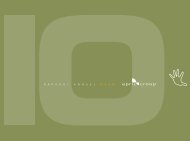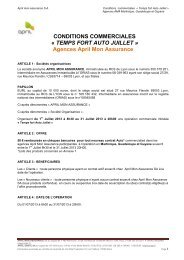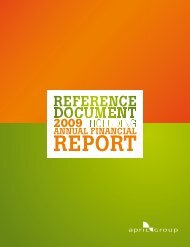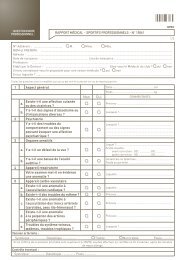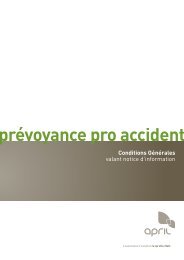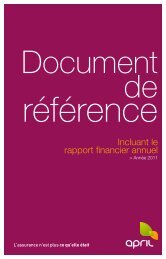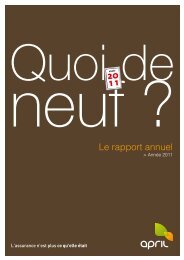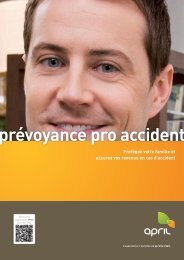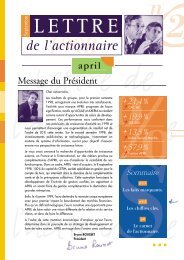2007 - April
2007 - April
2007 - April
Create successful ePaper yourself
Turn your PDF publications into a flip-book with our unique Google optimized e-Paper software.
2.0<br />
Notes to the consolidated financial statements at December 31 st <strong>2007</strong><br />
The latter is revised each year:<br />
Policyholder portfolios are amortized in proportion to their<br />
renewal rate, over a maximum period of 10 years.<br />
Software products are amortized over a period ranging from<br />
one to three years, depending on their planned useful life.<br />
1.13. Tangible fixed assets (excluding investment<br />
properties)<br />
In accordance with IAS 16, the gross value of tangible fixed<br />
assets corresponds to their acquisition or creation cost.<br />
Tangible fixed assets are valued on a historical cost basis and<br />
are not subject to any revaluations.<br />
Fixed assets are primarily self-financed and there are no<br />
assets that require a lengthy period of preparation in order<br />
to be able to be used or sold. As such, no borrowing costs are<br />
incorporated into the cost of assets.<br />
Maintenance and repair costs are booked directly under<br />
expenses for the year, with the exception of those making it<br />
possible to raise performance levels for the asset in question<br />
or increase its useful life.<br />
Amortization charges are calculated in line with the linear<br />
method based on the acquisition or production cost, after<br />
deducting, as relevant, the residual value. The depreciation<br />
period is based on the estimated useful life:<br />
Buildings are amortized over up to 50 years,<br />
General fixtures and fittings are amortized over up to eight years,<br />
Office equipment is amortized over up to five years,<br />
IT equipment is amortized over up to three years,<br />
Office furniture is amortized over up to five years.<br />
1.14. Investment properties<br />
In accordance with IAS 40, the Group has chosen to value<br />
investment properties based on the amortized cost method,<br />
i.e. based on the historical cost less cumulative deprecation<br />
charges.<br />
1.15. Fixed assets under finance-leases<br />
In accordance with IAS 17 “Leases”, fixed assets held under<br />
finance-leases are recorded under assets at the lower of their<br />
discounted value of future payments or their fair value. The<br />
corresponding debt is recorded as a liability under borrowings<br />
and financial debt.<br />
They are amortized in line with their estimated useful life as<br />
defined above.<br />
1.16. Impairment in value of assets<br />
Assets with an indefinite useful life are not amortized, but<br />
are subject to an annual impairment test. Assets that are<br />
amortized are subject to an impairment test when, due to<br />
specific circumstances of events, the collectability of their<br />
book values is called into question.<br />
1.16.1. Intangible fixed assets with a definite lifespan<br />
and tangible fixed assets:<br />
If there are any such signs, the recoverable value of fixed assets<br />
is estimated and an impairment in value is recorded when the<br />
book value of an asset is higher than its recoverable value.<br />
The recoverable value of an asset represents the higher of<br />
the asset’s net sales price or its going value, determined by<br />
estimating the future financial flows to be generated by the<br />
asset.<br />
1.16.2. Intangible fixed assets with an indefinite<br />
lifespan and goodwill:<br />
For this test, fixed assets are grouped together into cashflow<br />
generating units, which are defined as a consistent<br />
group of assets generating different cash inflows and<br />
outflows from other sets of assets.<br />
In light of the organization in place within the Group, cashflow<br />
generating units correspond either to subsidiaries or to<br />
groups of subsidiaries with common characteristics.<br />
The going value of assets is determined by discounting net<br />
future cash-flows (discounted cash-flow method).<br />
The financial flows based on activity forecasts for the<br />
next four years are discounted in line with the following<br />
assumptions:<br />
A risk-free rate of 4%, determined in relation to the rate<br />
for French government bonds,<br />
A risk rate of 4.07%, defined in relation to the risk premium<br />
demanded by investors on the small and midcap market,<br />
A sensitivity coefficient for the risk rate of between 1 and<br />
4, determined according to the activity of each subsidiary,<br />
its maturity, the existence or not of a portfolio of recurring<br />
activities and the breakdown of clients in this portfolio,<br />
A conservative infinite growth rate between 0% and<br />
2%, determined according to activity forecasts for the<br />
subsidiary.<br />
102<br />
Return to the contents section



